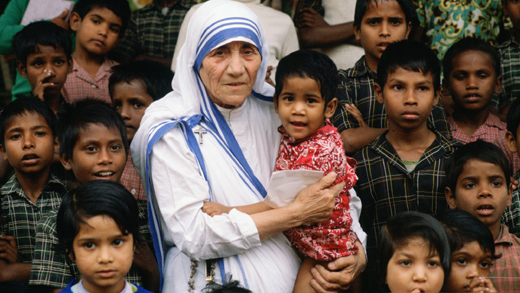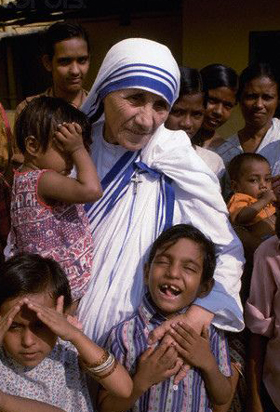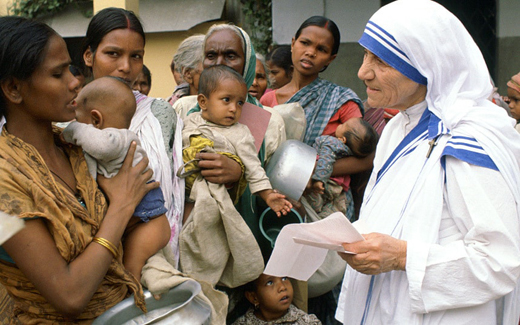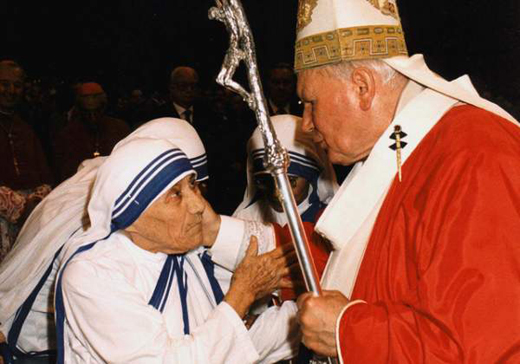Mother Teresa from gutters to Sainthood
Mother Teresa from gutters to Sainthood
Mangalore Today News Network
Mangaluru, September 3, 2016: Generations of Indians know her as a diminutive but determined woman in a blue-bordered white cotton sari who cared for the poor and destitute, Mother Teresa, who is due to become the Roman Catholic Church’s latest saint, also holds pride of place among the emissaries of compassion and service who have flourished and spread out from India, even if born elsewhere.

“By blood, I am Albanian. By citizenship, an Indian. By faith, I am a Catholic nun. As to my calling, I belong to the world. As to my heart, I belong entirely to the Heart of Jesus,” once said the Mother, who came to India in 1929 after deciding on a religious life the previous year and stayed the rest of her 87-year-long life mostly in Calcutta/Kolkata where she founded the Missionaries of Charity in 1948.
Starting small with one of its earliest ventures — a home for the dying — coming up in an abandoned Kali temple, it is now active in 133 countries, running homes for HIV/AIDS, leprosy and tuberculosis patients, soup kitchens, dispensaries and mobile clinics, orphanages, schools and counselling centres.
And her contribution to alleviating suffering and pain has made her name famous throughout the world — though, despite many legions of admirers, there is also a cohort or two of critics and detractors.
But it was not praise always for her — she had her detractors, specially polemic essayist Christopher Hitchens, who also testified during her beatification process, right-wing Hindu outfits, and more recently, Indian-origin British author and “militant atheist” Aroup Chatterjee, who have criticised her methods, motives and management, as well as adherence to church dogma on issues like abortion, divorce and contraception. Born on August 26, 1910, in Skopje town (capital of the independent country of Macedonia now but then part of the Ottoman Empire — and then under Serb, Bulgarian and then Yugoslav rule during her early life) as Anjeze (or Agnes, more commonly) Gonxhe Bojaxhiu, she was always religiously inclined.
Born on August 26, 1910, in Skopje town (capital of the independent country of Macedonia now but then part of the Ottoman Empire — and then under Serb, Bulgarian and then Yugoslav rule during her early life) as Anjeze (or Agnes, more commonly) Gonxhe Bojaxhiu, she was always religiously inclined.
According to a 1988 biography (“Mother Teresa” by Joan Graff Clucas), she was fascinated by stories of missionaries serving in Bengal and, even before her teenage years, decided on a religious life. She left home in 1928 to join the Sisters of Loreto in Ireland to learn English, with a view to becoming a missionary, and never saw her mother or her sister again (her father had died in 1919).
In India, she was initially based in a convent in Darjeeling where she learnt Bengali and taught at the nearby St. Teresa’s School. As a nun, she chose to be named after Therese de Lisieux, the patron saint of missionaries, but because another nun there had already chosen that name, she opted for the Spanish spelling of Teresa.
Taking her solemn vows in May 1937 while a teacher (and subsequently headmistress) at the Loreto Convent in Calcutta’s Entally, she enjoyed teaching but was greatly concerned at the poverty and pain around, especially after the 1943 famine and the 1946 communal riots. It was in September 1946 that she experienced what she later termed “the call within the call” on a train from Calcutta to Darjeeling, urging that she “leave the convent and help the poor while living among them” (as recounted to Clucas).

Replacing the nun’s habit for the sari, she began missionary work with the poor in Calcutta in 1948 after taking Indian citizenship and spending a few months in Patna for basic medical training. Initially, she started a school but soon started taking care of the destitute, and was, in 1949, joined by a group of young women, which later became the Missionaries (Vatican approval was accorded in October 1950).
Though it faced initial problems, the organisation soon went from strength to strength — with her contribution recognised by both India (she was conferred the Padma Shri in 1962 and the Bharat Ratna in 1980) and the world (especially after British journalist Malcolm Muggeridge’s 1969 documentary “Something Beautiful for God”) with the Ramon Magsaysay Award in 1962, the Nobel Peace Prize in 1979 and many others.
And it was not only in India that she was active — she personally rescued three dozen children from a Beirut hospital in 1982 after arranging a temporary cease-fire between the Israeli army and Palestinian guerrillas, tended to starvation victims in Ethiopia, radiation-afflicted at Chernobyl, and earthquake victims in Armenia.
However, her health slowly started failing from 1983 when she had her first heart attack and when further complications arose in 1991, she offered to step down but her offer was declined. She finally demitted office in March 1997 after a spate of other injuries and illnesses and died on September 5 the same year.

Pope John Paul II greets Mother Teresa at the Vatican in Rome in June, 1997
The same year the process to canonisation started with the beatification process, the third and penultimate step before being declared a saint, and requiring a miracle to be attributed to her. Normally, the first step itself begins five years after the person’s death, but in her case, the waiting period was waived by then Pope, John Paul II. In 2002, she was ‘beatified’, becoming ‘Blessed Teresa’ after the Vatican recognised a miracle attributed to her – a locket containing her picture curing the tumour of an Indian woman. The second miracle – needed to become a saint – was recognised in December 2015. St Teresa of Kolkota is set to be canonoised at the vatican on September 4, Sunday.
The main events planned around the canonization of Mother Teresa: Programme:
Sept. 1, “feast for the poor and Missionaries of Charity family,” including a musical based on Mother Teresa’s life.
Masses Sept. 2 in various languages in Rome’s Basilica of St. Anastasia al Palatino and veneration of her relics. In the evening, a prayer vigil with solemn eucharistic adoration will be held at Rome’s Basilica of St. John Lateran with Cardinal Agostino Vallini, the papal vicar of Rome, presiding.
Catechesis Sept. 3 by Pope Francis for the jubilee celebration of workers and volunteers for mercy. In the evening, a prayer and musical meditation will be held at Rome’s Basilica of St. Andrea della Valle followed by veneration of Mother Teresa’s relics and Mass.
Canonization Mass Sept. 4. Pilgrims will be able to venerate St. Teresa’s relics in the evening at the Basilica of St. John Lateran.
Celebration Sept. 5 of a Mass of thanksgiving and the first feast of St. Teresa of Kolkata in St. Peter’s Basilica with Cardinal Pietro Parolin, Vatican secretary of state, presiding. Pilgrims will be able to venerate the relics of St. Teresa at St. John Lateran in the evening.
Sept. 6, continuing veneration of the relics of St. Teresa at St. John Lateran.
Sept. 7-8, veneration of the relics of St. Teresa of Kolkata at Rome’s Church of St. Gregory the Great, along with the possibility of visiting her room at the convent of St. Gregory.
- Rethinking Drug Seizure Coverage: A Call for Health-Centred Narratives
- Substance abuse - A pressing concern among medical students
- China is winning the trade war without fighting
- Poll promises can become political nightmares
- While India sticks to death by hanging other execution methods vary across the world
- Spiking of drinks, a grave threat for students’ security
- Burden of drugs and substance use among university students in India
- Mangalore medic’s miracle in Bombay 1957
- Needed a national protocol for treatment of substance use disorders
- The Lingering Menace of Drug Abuse Among the Indian Youth—It’s Time for Action
- Need For ‘Students, Alcohol and Drugs’ survey
- New Synthetic Drugs Trapping Youth
- Mood Modifying Chips - Future of Drug Use
- Kashmir Bhavan in Bengaluru: A must visit place
- "MAI and I" Book of Angelic Emotions
- Draupadi Murmu - The New ’President of India’
- Anthony Ashram in the city grows a classic museum
- First College of Fisheries in India - A Golden Jubilarian
- Flushing Meadows - A Vintage Mansion
- The Colonel�s Bequest
- A Mangalorean PM and his RBI Governor Brother: The Extraordinary story of the Benegal Brothers
- There is no higher religion than Truth: Theosophical Society
- L�affaire - Ashu & Yiju of Mangalore
- Mangalore in Kowloon
- 1568 to 2018 AD: 450 years of Christianity in Mangaluru
- Vice President elect Naidu moves on from nadir to zenith, the phenomenal journey
- Embracing the Outdoors: How Heated Jackets Are Revolutionizing Cold Weather Activities
- Efficient and Sustainable Packaging Solutions with FIBCs
- The Hybrid Kilt Revolution | Where Tradition Gets Trendy
- Affordable Elegance | Embrace Style on a Budget with Cheap Kilts
- Unleashing Style and Functionality | Exploring Tactical Kilts
- Mangalore’s Heroic Lady marks 105th Birthday
- Santa the Christmas spirit
- Geriatric care: Mangalore strikes a fine balance
- The Don Who Made Two Empires to Clash
- CHITRAPUR SARASWATS - A Great Kanara Community
- Our new President Ram Nath Kovind’s significant journey to Rashtrapathi Bhavan
- Marriages made in heaven, big fat weddings made in India
- Eid insight - The giver of glad tidings
- CITY INFORMATION
- TRAVEL
- TOURIST INFORMATION
- HEALTH CARE
- MISCELLANEOUS




 Write Comment
Write Comment E-Mail To a Friend
E-Mail To a Friend Facebook
Facebook Twitter
Twitter  Print
Print 


